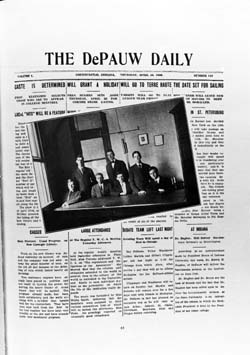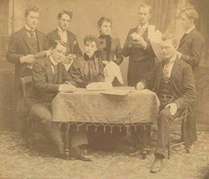
|
In the early DePauw period campus publications continued to serve as an outlet for the expression of student opinion and literary creativity. The Asbury Monthly became the DePauw Monthly in 1884 and lasted four more years under the sponsorship of the fading literary societies. Its successor was the biweekly Adz, published by the short-lived DePauw Literary Society from 1888 to 1890, when factionalism brought about a split in the editorial staff resulting in two separate papers, both called the Adz. These soon became the Bema and the Record, each controlled by a combination of social fraternities and published weekly. Finally in the fall of 1893 they were replaced by a single DePauw Weekly. When Charles A. Beard became editor in 1897 he changed its name to the Palladium, which continued until 1904, becoming then simply The DePauw. Three years later, under the auspices of the newly organized DePauw Press Club and its sponsor, Professor Nathaniel W. Barnes, appeared the DePauw Daily, an ambitious enterprise that endured until 1920.
___________________________________
These student papers were generally four-page sheets each printed
in four columns, with a great deal of space devoted to local advertisements
to help pay the printer. Printed on the press of the Greencastle
Herald or another local daily, with headlines set by hand, the papers
frequently contained typographical and other errors. A limited number
of photographs and line drawings were employed. Particularly outstanding
were the drawings of Paul "Pete" Willis, later a cartoonist
for the Indianapolis Star, whose work also appeared in the college
yearbook. Under the guidance of Professor Barnes, who taught a course
on reporting and editorial work, student journalism at DePauw became
more and more professional. Among the staff on the DePauw Daily
were such men as Kenneth C. Hogate, W. Don Maxwell, and Eugene C.
Pulliam, who later headed the mastheads of the Wall Street Journal,
the Chicago Tribune, and the Indianapolis Star, respectively. ______________________________________
The
editorial staff of the Bema, a weekly school
|
Depauw University e-history | E-mail comments to: archives@depauw.edu


 _____________________________________
_____________________________________